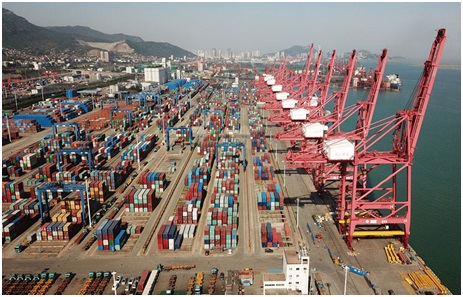By Du Haitao from People’s Daily
China’s foreign trade saw steady development and its structure has been improved in the first four months of this year as the sector seeks high-quality growth.
The country’s foreign trade of goods grew 4.3 percent year on year during this period to 9.51 trillion yuan ($1.41 trillion), customs data showed.
Exports increased by 5.7 percent year on year to 5.06 trillion yuan during this period, while imports went up by 2.9 percent to 4.45 trillion yuan, the General Administration of Customs (GAC) said. Trade surplus rose by 31.8 percent to 618.2 billion yuan.
In April, foreign trade of China expanded by 6.5 percent and reached 2.51 trillion yuan. Exports grew by 3.1 percent to 1.3 trillion yuan, while imports jumped by 10.3 percent to 1.21 trillion yuan. Trade surplus stood at 93.57 billion yuan in the month, shrinking by 43.8 percent year on year.
The volume of China’s general foreign trade grew 6.6 percent to 5.68 trillion yuan in the first four months, accounting for 59.8 percent of foreign trade and up 1.3 percentage points from the same period last year.
The endogenous energy for foreign trade was further released. In the first four months, private enterprises’ imports and exports increased by 11 percent to 3.9 trillion yuan, accounting for 41 percent of China’s total foreign trade and moving up 2.5 percentage points from the same period last year.
The private sector has become a major force boosting foreign trade growth, and is showing stronger willingness to take part in foreign trade.
China’s foreign trading partners became diverse in the first four months. Trade between China and the European Union (EU), the ASEAN, and Japan all increased. China’s trade with Belt and Road countries totaled 2.73 trillion yuan, up 9.1 percent year on year. The growth was 4.8 percentage points higher than the overall trade growth in the period, and the trade volume accounted for 28.7 percent of the country’s total foreign trade, up by 1.3 percentage points from a year ago.
The structure of foreign trade was further optimized. In the first four months, exports of mechanical and electrical products increased by 4.5 percent to 2.97 trillion yuan, accounting for 58.6 percent of total exports.
The export value of electromechanical products was 1.33 trillion yuan, an increase by 4.5 percent, and that of mechanical equipment was 890.56 billion yuan, up by 3.9 percent. Imports of crude oil and natural gas increased while that of soybeans dropped. The prices of imported bulky commodities reported both increases and drops.
Li Kuiwen, director of the GAC’s statistics and analysis department, attributed the steady growth of foreign trade in the January-April period to the stable growth of China’s economy. The purchase managers’ index in the manufacturing sector in April was 50.1 percent and is still growing.
The overall health of the market has improved, despite a marginal fall in the growth of supply and demand, and external demand has kept increasing, Li said.
In addition, policies to stabilize foreign trade and foreign investment released since last year took further effects, continuing to create a sound foreign trade environment.
The steady growth of China’s foreign trade in the first four months is expected to bolster global economic confidence and stabilize global trade, at a time when some international organizations projected slower growth of global economy and trade and some of China’s surrounding economies experienced a fall in exports for months in a row.
In the first four months, China’s trade with EU grew by 11.8 percent to 1.5 trillion yuan, accounting for 15.7 percent of the country’s foreign trade. China’s trade with its second largest trading partner ASEAN increased by 9 percent to 1.28 trillion yuan, accounting for 13.4 percent of the country’s foreign trade. In the period, China’s exports to the ASEAN grew by 13.4 percent to 714.35 billion yuan and its imports from the latter grew by 3.8 percent to 562.13 billion yuan.
The GAC is taking active measures to reduce the time to prepare for customs clearance. It has also slashed time for customs clearance and reduced burden for enterprises through carrying out pilot customs bonds insurance service nationwide and extending the function to other customs-related procedures such as taxation and guarantee.
The administration has also worked with the Ministry of Transport and the State Administration for Market Regulation to strengthen supervision on the implementation of the port charges list system so as to reduce costs related to imports and exports. Since April, port facility security fees and harbor dues at nationwide ports were cut by 20 percent and 15 percent, respectively.
Customs departments across the country are earnestly implementing the national policy of stabilizing employment, finance, foreign trade, foreign capital, investment and expectation, Li introduced.
They are also taking constant efforts to improve port business environment, promote cross-border trade facilitation, consolidating the outcome of customs clearance time reduction, further reducing costs related to imports and exports, slashing the number of certificates needed in imports and exports, improving efficiency and reducing fees in order to deliver more sense of gain to enterprises and ensuring that foreign trade grows steadily and its quality is improved, he added.
Photo taken on May 8, 2019 shows containers placed in an orderly manner at a port in Lianyungang, east China’s Jiangsu Province. Photo by People’s Daily Online










Leave a Comment